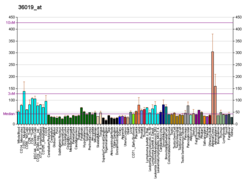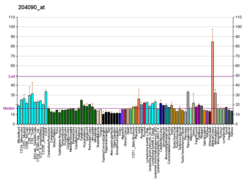STK19
Protein-coding gene in the species Homo sapiens
| STK19 | |||||||||||||||||||||||||||||||||||||||||||||||||||
|---|---|---|---|---|---|---|---|---|---|---|---|---|---|---|---|---|---|---|---|---|---|---|---|---|---|---|---|---|---|---|---|---|---|---|---|---|---|---|---|---|---|---|---|---|---|---|---|---|---|---|---|
| Identifiers | |||||||||||||||||||||||||||||||||||||||||||||||||||
| Aliases | STK19, D6S60, D6S60E, G11, HLA-RP1, RP1, serine/threonine kinase 19 | ||||||||||||||||||||||||||||||||||||||||||||||||||
| External IDs | OMIM: 604977; MGI: 1860085; HomoloGene: 10449; GeneCards: STK19; OMA:STK19 - orthologs | ||||||||||||||||||||||||||||||||||||||||||||||||||
| |||||||||||||||||||||||||||||||||||||||||||||||||||
| |||||||||||||||||||||||||||||||||||||||||||||||||||
| |||||||||||||||||||||||||||||||||||||||||||||||||||
| |||||||||||||||||||||||||||||||||||||||||||||||||||
| |||||||||||||||||||||||||||||||||||||||||||||||||||
| Wikidata | |||||||||||||||||||||||||||||||||||||||||||||||||||
| |||||||||||||||||||||||||||||||||||||||||||||||||||
Serine/threonine-protein kinase 19 is an enzyme that in humans is encoded by the STK19 gene.[5][6][7]
This gene encodes a serine/threonine kinase which localizes predominantly to the nucleus. Its specific function is unknown; it is possible that phosphorylation of this protein is involved in transcriptional regulation. This gene localizes to the major histocompatibility complex (MHC) class III region on chromosome 6 and expresses two transcript variants.[7]
See also
References
- ^ a b c ENSG00000206342, ENSG00000236250, ENSG00000226033, ENSG00000204344, ENSG00000234947 GRCh38: Ensembl release 89: ENSG00000226257, ENSG00000206342, ENSG00000236250, ENSG00000226033, ENSG00000204344, ENSG00000234947 – Ensembl, May 2017
- ^ a b c GRCm38: Ensembl release 89: ENSMUSG00000061207 – Ensembl, May 2017
- ^ "Human PubMed Reference:". National Center for Biotechnology Information, U.S. National Library of Medicine.
- ^ "Mouse PubMed Reference:". National Center for Biotechnology Information, U.S. National Library of Medicine.
- ^ Sargent CA, Anderson MJ, Hsieh SL, Kendall E, Gomez-Escobar N, Campbell RD (Jul 1994). "Characterisation of the novel gene G11 lying adjacent to the complement C4A gene in the human major histocompatibility complex". Hum Mol Genet. 3 (3): 481–8. doi:10.1093/hmg/3.3.481. PMID 8012361.
- ^ Gomez-Escobar N, Chou CF, Lin WW, Hsieh SL, Campbell RD (Dec 1998). "The G11 gene located in the major histocompatibility complex encodes a novel nuclear serine/threonine protein kinase". J Biol Chem. 273 (47): 30954–60. doi:10.1074/jbc.273.47.30954. PMID 9812991.
- ^ a b "Entrez Gene: STK19 serine/threonine kinase 19".
Further reading
- Yu CY (1991). "The complete exon-intron structure of a human complement component C4A gene. DNA sequences, polymorphism, and linkage to the 21-hydroxylase gene". J. Immunol. 146 (3): 1057–66. doi:10.4049/jimmunol.146.3.1057. PMID 1988494.
- Shen L, Wu LC, Sanlioglu S, et al. (1994). "Structure and genetics of the partially duplicated gene RP located immediately upstream of the complement C4A and the C4B genes in the HLA class III region. Molecular cloning, exon-intron structure, composite retroposon, and breakpoint of gene duplication". J. Biol. Chem. 269 (11): 8466–76. doi:10.1016/S0021-9258(17)37217-4. PMID 8132574.
- Ulgiati D, Townend DC, Christiansen FT, et al. (1996). "Complete sequence of the complement C4 gene from the HLA-A1, B8, C4AQ0, C4B1, DR3 haplotype". Immunogenetics. 43 (4): 250–2. doi:10.1007/BF00587313. PMID 8575831.
- Yang Z, Shen L, Dangel AW, et al. (1998). "Four ubiquitously expressed genes, RD (D6S45)-SKI2W (SKIV2L)-DOM3Z-RP1 (D6S60E), are present between complement component genes factor B and C4 in the class III region of the HLA". Genomics. 53 (3): 338–47. doi:10.1006/geno.1998.5499. PMID 9799600.
- Strausberg RL, Feingold EA, Grouse LH, et al. (2003). "Generation and initial analysis of more than 15,000 full-length human and mouse cDNA sequences". Proc. Natl. Acad. Sci. U.S.A. 99 (26): 16899–903. Bibcode:2002PNAS...9916899M. doi:10.1073/pnas.242603899. PMC 139241. PMID 12477932.
- Mungall AJ, Palmer SA, Sims SK, et al. (2003). "The DNA sequence and analysis of human chromosome 6". Nature. 425 (6960): 805–11. Bibcode:2003Natur.425..805M. doi:10.1038/nature02055. PMID 14574404.
- Xie T, Rowen L, Aguado B, et al. (2004). "Analysis of the gene-dense major histocompatibility complex class III region and its comparison to mouse". Genome Res. 13 (12): 2621–36. doi:10.1101/gr.1736803. PMC 403804. PMID 14656967.
- Lehner B, Semple JI, Brown SE, et al. (2004). "Analysis of a high-throughput yeast two-hybrid system and its use to predict the function of intracellular proteins encoded within the human MHC class III region". Genomics. 83 (1): 153–67. doi:10.1016/S0888-7543(03)00235-0. PMID 14667819.
- Wadle A, Mischo A, Henrich PP, et al. (2005). "Characterization of Hap/BAG-1 variants as RP1 binding proteins with antiapoptotic activity". Int. J. Cancer. 117 (6): 896–904. doi:10.1002/ijc.21259. PMID 15986447. S2CID 36464436.
- v
- t
- e
Serine/threonine-specific protein kinases (EC 2.7.11.21-EC 2.7.11.30) | |||||||||||||||||||||
|---|---|---|---|---|---|---|---|---|---|---|---|---|---|---|---|---|---|---|---|---|---|
| |||||||||||||||||||||
Dual-specificity kinases (EC 2.7.12) | |||
|---|---|---|---|
| |||
 | This article on a gene on human chromosome 6 is a stub. You can help Wikipedia by expanding it. |
- v
- t
- e



















